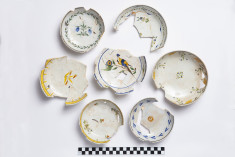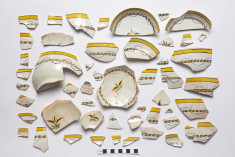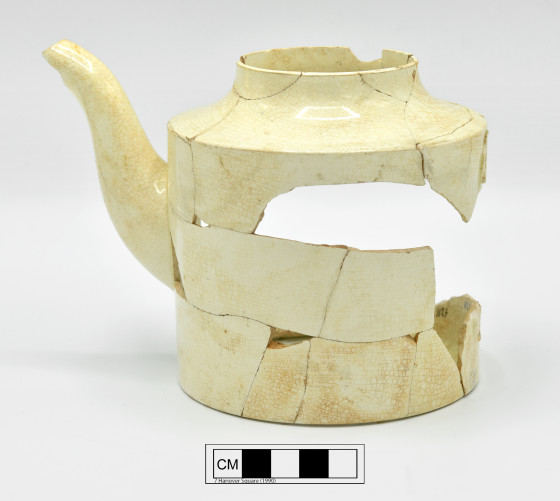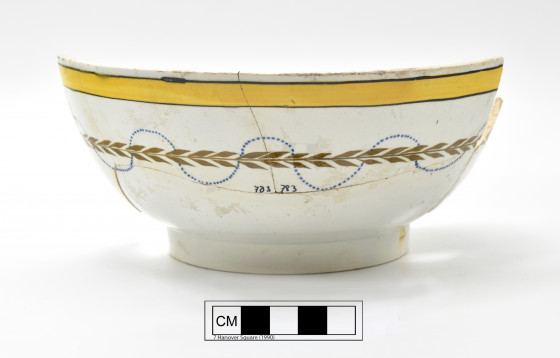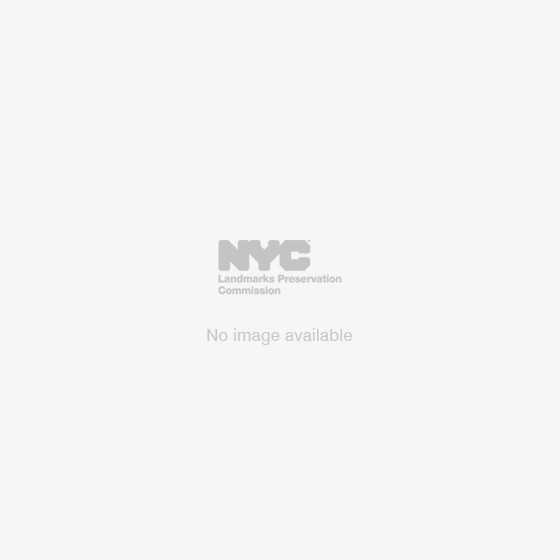This context (Cat# 783, Lot 27*, Shovel Test 16, Strat 2, Level c) consists of artifacts from an undisturbed portion of a ceramic shop deposit located in Lot 27*. The ceramic dump was sampled with Test Cut AO, Shovel Test 16 and Shovel Test 22. During the exploratory phase of the project, Shovel Test 16 was placed in Lot 27* approximately five feet west of the Lot 27*/28* boundary wall, in line with the stone wall uncovered in Test Cut J in Lot 28. The objective was to determine whether the stone wall extended eastward into Lot 27*. At the time that Shovel Test 16 was excavated, clearing operations had removed the brick floor of the latest building in Lot 9, a large hotel which stood on the former Lots 9*, 10*, 26* and 27*. Because of the clearing operations, excavation of Shovel Test 16 began some 12 inches below the level of the brick floor. Shovel Test 16 did not encounter the stone wall uncovered in Test Cut J, but it did reveal a dense deposit of ceramics in a matrix of red and light brown sand. The western part of the shovel test encountered a number of stones which seemed to be part of a wall. There also appeared to be a stone wall in the eastern portion of Shovel Test 16. The ceramic deposit was excavated to its base at a depth of 30 inches below the brick floor. During the mitigation phase of the project, the excavators decided to obtain a larger sample from this deposit, so Test Cut AO, measuring four by six feet, was placed so that the area excavated as Shovel Test 16 was located within the bounds of the test cut, in the east central portion.
The deposit was sealed by an overlying brick floor which extended over the foundation wall next to which the deposit had accumulated. According to the field notes, the trash deposit itself was about 50-60% ceramics in a sand matrix. Small quantities of bottle glass, bone, and oxidized metal were recovered as well. The ceramics and their matrix were not packed tightly and there were air spaces between some of the sherds. The large size of many of the sherds indicate that they were not subject to extensive trampling and breaking after deposition and many of the fresh breaks can be attributed to the passage of heavy equipment over this area. Under this deposit was a mortar floor. The cut stone walls at the southern and eastern border of Test Cut AO and the associated mortar floor may have represented a backyard area or, more likely, the interior of a covered extension of a building standing on the site in the late 18th and early 19th centuries.
The entire deposit contained 15,582 sherds of undecorated creamware, 227 sherds of decorated creamware, 11,740 sherds of underglaze polychrome painted pearlware, 5794 sherds of plain pearlware, 621 sherds of other pearlwares, and 1759 sherds of Chinese export porcelain, making a combined total of 35,814 sherds. The excavators believe that this deposit accumulated rapidly and represented a limited number of dumping episodes rather than normal, occasional breakage from a china shop. The reasons for this theory are as follows: there are sherds which crossmend throughout the deposit, vessel forms and decorations are uniform, matched sets of pearlwares and Chinese porcelain are present, and there is a rather limited number of vessel forms represented overall. The sherds are likely to be the remains of a merchant's disaster of one sort or another. They might have broken in shipment from England or represent some stroke of bad luck that fell upon the shop's inventory. It is also possible that the wares were discarded because they were no longer in fashion and thus unmarketable, but this is unlikely because it would be unusual for a merchant to dispose of outdated wares by throwing them out rather than by selling them at reduced prices.
The documentary research indicates that from 1794 to 1795, John Elting ran a "China, Glass and Earthenware" shop on the lot, and between 1798 to 1820, John Manley ran a "Glass and China Store.” The ceramic deposit in the sandy matrix most likely represents the deposition of breakage from one or both of these china shops. The breakage was apparently dumped behind the shop in the alley way or covered extension which probably extended from the stone wall in the eastern portion of Test Cut AO and Shovel Test 22 to the Lot 27*/28 boundary wall. Workers in the shop may have disposed of their lunch refuse in the same area, accounting for the presence of bone in the deposit. With the exception of Shovel Test 16 and the eastern portion of Test Cut AO, the ceramic deposit was heavily disturbed by later events. Since the top of the undisturbed ceramic deposit was at the same level as the top of the cut stone wall, it is possible that the disturbance of the deposit was associated with the demolition of the building extension. For more information about the excavation and artifact analysis of Test Cut AO, Shovel Test 16 and Shovel Test 22, please see pages 101 to 112 of the 7 Hanover Square site report.
-
Collection method
Excavated this context using shovels and trowels. Part of the soil was dry screened and part of the soil was wet screened using 1/4 inch mesh.
-
Soil
Red sand


